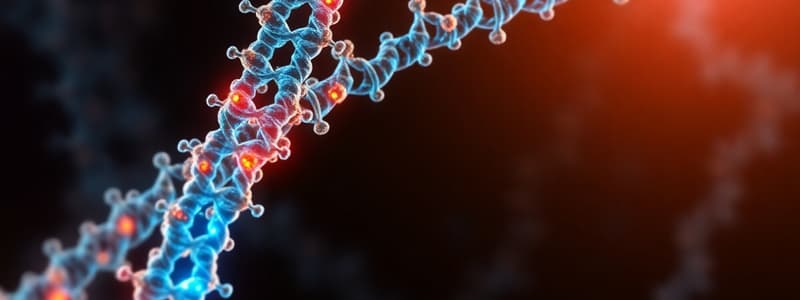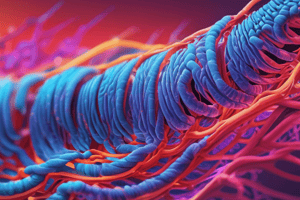Podcast
Questions and Answers
What structure allows the myosin head to bind to actin during muscle contraction?
What structure allows the myosin head to bind to actin during muscle contraction?
- Myosin tail
- ATP binding site
- Hinge on myosin (correct)
- Actin filament structure
What happens when ATP is hydrolyzed during the crossbridge cycle?
What happens when ATP is hydrolyzed during the crossbridge cycle?
- Tropomyosin moves away from the binding sites
- Myosin detaches from actin
- Energy is transferred to the myosin head (correct)
- Energy is released to the actin
Which protein is primarily responsible for covering the myosin-binding sites on actin at rest?
Which protein is primarily responsible for covering the myosin-binding sites on actin at rest?
- Tropomyosin (correct)
- Troponin
- Actin
- Myosin
What does the term 'power stroke' refer to in muscle contraction?
What does the term 'power stroke' refer to in muscle contraction?
Which of the following statements about actin is true?
Which of the following statements about actin is true?
How does the myosin molecule resemble a golf club during its action?
How does the myosin molecule resemble a golf club during its action?
Why is ATP essential for muscle contraction?
Why is ATP essential for muscle contraction?
What role do calcium ions play in muscle function?
What role do calcium ions play in muscle function?
What primarily composes the thick filaments in the sarcomere?
What primarily composes the thick filaments in the sarcomere?
During the contraction of a muscle, which structure remains unchanged in length?
During the contraction of a muscle, which structure remains unchanged in length?
Which of the following molecules is NOT directly involved in the sliding filament theory of contraction?
Which of the following molecules is NOT directly involved in the sliding filament theory of contraction?
What is the primary role of calcium ions in muscle contraction?
What is the primary role of calcium ions in muscle contraction?
How do the T tubules contribute to muscle contraction?
How do the T tubules contribute to muscle contraction?
What happens to the sarcomere during muscle contraction according to the sliding filament theory?
What happens to the sarcomere during muscle contraction according to the sliding filament theory?
Which protein is involved in the structural integrity of the thin filament?
Which protein is involved in the structural integrity of the thin filament?
How does ATP contribute to muscle contraction?
How does ATP contribute to muscle contraction?
What is the primary role of tropomyosin in muscle contraction?
What is the primary role of tropomyosin in muscle contraction?
Which component of the troponin complex is specifically responsible for binding calcium ions?
Which component of the troponin complex is specifically responsible for binding calcium ions?
Which statement best describes the power stroke in muscle contraction?
Which statement best describes the power stroke in muscle contraction?
What is the role of ATP in the process of muscle contraction?
What is the role of ATP in the process of muscle contraction?
Which statement about the thin filaments in a sarcomere is correct?
Which statement about the thin filaments in a sarcomere is correct?
What triggers the conformational change in the troponin-tropomyosin complex?
What triggers the conformational change in the troponin-tropomyosin complex?
What is the result of myosin binding to an exposed binding site on actin?
What is the result of myosin binding to an exposed binding site on actin?
Which of the following statements accurately describes the role of troponin I?
Which of the following statements accurately describes the role of troponin I?
Flashcards are hidden until you start studying
Study Notes
Myosin Molecule
- Myosin has a tail and two heads, also known as cross-bridges.
- The shape of a myosin molecule resembles a golf spoon with two heads.
- The myosin head has the ability to move back and forth, which provides the power stroke for muscle contraction.
- The myosin tail has a hinge that allows for vertical movement enabling the cross-bridge to bind to actin.
ATP and Actin Binding Sites
- The cross-bridge has two binding sites: one for ATP and one for actin.
Energized Cross-Bridge
- ATP is a high energy molecule.
- Binding ATP to the myosin molecule transfers energy to the myosin cross-bridge.
- Hydrolysis of ATP into ADP and phosphate releases energy, which is transferred to the myosin head.
- The myosin head is in a low-energy state before ATP binding and a high-energy state after ATP hydrolysis.
Thin Filaments of Sarcomere
- Thin filaments are composed of three protein molecules: actin, tropomyosin, and the troponin complex.
- Actin is the primary component of the thin filament.
- Actin subunits are twisted into a double helical chain.
- Each actin subunit has a specific binding site for the myosin cross-bridge.
- Actin is a globular protein in its G-actin form.
- G-actin is polymerized into two strands, forming an alpha-helical structure called F-actin.
- Actin has myosin-binding sites that are covered by tropomyosin when the muscle is at rest, preventing actin and myosin interaction..
- Tropomyosin is a regulatory protein that twists around the actin filament.
- In unstimulated muscle, tropomyosin covers the binding sites on actin subunits, preventing myosin cross-bridge binding.
- Troponin is a third molecule, called the troponin complex, that is attached periodically to the tropomyosin strand.
- Troponin facilitates the movement of tropomyosin to expose the binding sites on actin for myosin.
Troponin Complex
- Troponin is a heterotrimer consisting of:
- Troponin T: binds to a single molecule of tropomyosin.
- Troponin I: binds to actin and inhibits contraction, facilitating the inhibition of myosin binding to actin by tropomyosin.
- Troponin C: binds calcium ions (Ca2+) and promotes the movement of tropomyosin.
Six Steps of Single Cross-Bridge Cycling
- Step 1: Exposure of binding sites on actin:
- An action potential in the muscle cell membrane leads to the release of calcium ions from the terminal cisternae.
- Calcium ions bind to troponin, causing a conformational change in the troponin-tropomyosin complex.
- Tropomyosin moves away from the myosin binding sites on actin, exposing them.
- Step 2: Binding of myosin to actin:
- Once the binding site on actin is exposed, the energized cross-bridge binds to actin.
- Step 3: Power stroke of the cross-bridge:
- ADP and inorganic phosphate (Pi) are released from the myosin head.
- The myosin head tilts backward, pulling the thin filament towards the center of the sarcomere.
- Step 4: Disconnecting the cross-bridge:
- An ATP molecule binds to the myosin cross-bridge, disconnecting it from actin.
- Step 5: Re-energizing the cross-bridge:
- ATP is hydrolyzed into ADP and phosphate, providing energy for the myosin head to return to its original position.
- Step 6: Preparation for the next cycle:
- The cycle repeats as long as calcium ions are present and ATP is available.
Skeletal Muscle Physiology of Contraction
- The process of muscle contraction involves three stages:
- Synaptic transmission at the neuromuscular junction: Nerve impulses trigger the release of neurotransmitters at the neuromuscular junction.
- Excitation-contraction coupling: The nerve impulse triggers a series of events that lead to the release of calcium ions from the sarcoplasmic reticulum.
- Contraction-relaxation cycle: Calcium ions bind to troponin, initiating the sliding filament mechanism.
Transverse Tubules
- The transverse (T) tubules are an extensive network of muscle cell membrane that invaginates deep into the muscle fiber.
- T tubules carry depolarization from action potentials at the muscle cell surface to the interior of the fiber.
- T tubules make contact with the terminal cisternae of the sarcoplasmic reticulum and contain a voltage-sensitive protein called the dihydropyridine receptor (DHP).
Calcium Release
- Membrane depolarization opens the L-type Ca2+ channel, also known as the DHP receptor.
- The DHP receptor is mechanically coupled to the Ca2+ release channel (ryanodine receptor; RyR), causing it to open.
- Ca2+ exits the sarcoplasmic reticulum (SR) via the RyR channel and activates troponin C, leading to muscle contraction.
Sarcomere
- The sarcomere is the functional unit of a muscle fiber that contains contractile units called myofilaments.
- Thick Filaments: primarily composed of myosin.
- Thin Filaments: contain actin, troponin, and tropomyosin.
Sliding Filament Theory of Contraction
- The Sliding Filament Theory describes how muscle cells contract.
- During contraction, the sarcomere shortens, and thin and thick filaments overlap to a greater degree.
- The thick and thin filaments do not change length during contraction.
- Actin filaments slide over the myosin filaments, moving toward the M line in the center of the sarcomere.
- The A band does not change length, but the H zone and I band get shorter during filament overlap.
Molecular Participants of Sliding Theory
- The Sliding Filament Theory involves the activities of five different molecules:
- Actin: The thin filament protein that binds to myosin.
- Myosin: The thick filament protein that binds to actin and generates the power stroke.
- Tropomyosin: A regulatory protein that covers the myosin binding sites on actin when the muscle is at rest.
- Troponin: A complex of proteins that regulate the interaction of tropomyosin with actin.
- ATP: The energy source for muscle contraction.
- Calcium ions are also involved in the process of muscle contraction.
Studying That Suits You
Use AI to generate personalized quizzes and flashcards to suit your learning preferences.




